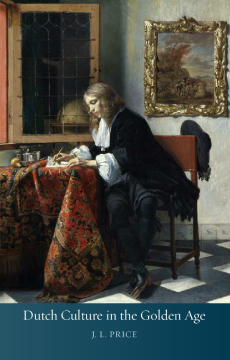
Additional Information
Book Details
Abstract
The seventeenth century is considered the Dutch Golden Age, a time when the Dutch were at the forefront of social change, economics, the sciences, and art. In Dutch Culture in the Golden Age, eminent historian J. L. Price goes beyond the standard descriptions of the cultural achievements of the Dutch during this time by placing these many achievements within their social context. Price’s central argument is that alongside the innovative tendencies in Dutch society and culture there were powerful conservative and reactionary forces at work—and that it was the tension between these contradictory impulses that gave the period its unique and powerful dynamic.
Dutch Culture in the Golden Age is distinctive in its broad scope, examing art, literature, religion, political ideology, theology, and scientific and intellectual trends, while also attending to the high and popular culture of the times. Price’s new interpretation of Dutch history places an emphasis on the paradox of the Dutch resistance to change as well as their general acceptance of innovation.
This comprehensive look at the Dutch Golden Age provides a fascinating new way to understand Dutch culture at the height of its historic and global influence.
“Price has drawn on his long career studying the seventeenth-century Dutch Republic to examine the nature of the society and culture which gave birth to, nurtured, and was in turn influenced by, the Golden Age . . . a very readable and clear picture of the Dutch in the seventeenth century.” — Times Literary Supplement
“Dutch Culture in the Golden Age is a lucid essay that offers a rich and rewarding, and exceptionally nuanced, insight in the culture—more than just painting and literature —of seventeenth-century Holland.” — Reviews in History
“Price emphasizes the balance of Dutch innovation versus resistance to change and is especially good at his comparisons to the wider European world at the time . . . Price’s chapter on Dutch influences on European and even world history is particularly insightful, pointing out how the traditional views of early modern Europe ignore some of the most interesting developments that took place in the Netherlands. Recommended.” — Choice
“Part of what makes the book interesting is the diversity of its discussion, ranging from the ups and downs of the tulip trade to the visual arts. The latter are illuminated with beautiful black and white paintings. . . . This volume provides a helpful introduction to the art, science, and literature of the Netherlands in the seventeenth century. Its interdisciplinary approach will enrich readers’ understanding of Dutch culture, especially since, in this day of specialization, it is too easy to forget that human life is a tapestry of many threads.” — The Sixteenth Century Journal
J. L. Price is a former reader in history at the University of Hull and one of the leading authorities on the history of the Dutch Republic. He is the author, most recently, of Dutch Society, 1588–1712.
